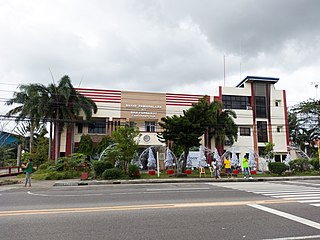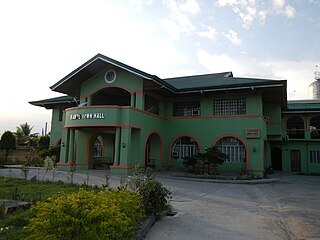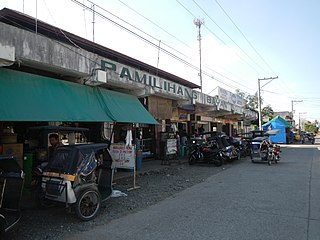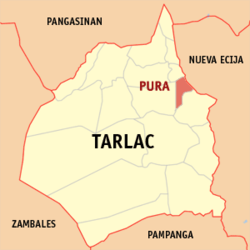
Tayasan, officially the Municipality of Tayasan, is a 3rd class municipality in the province of Negros Oriental, Philippines. According to the 2020 census, it has a population of 38,159 people.

Claveria, officially the Municipality of Claveria, is a 3rd class municipality in the province of Cagayan, Philippines. According to the 2020 census, it has a population of 31,900 people.

Buenavista, officially the Municipality of Buenavista, is a 1st class municipality in the province of Agusan del Norte, Philippines. According to the 2020 census, it has a population of 68,892 people.

Gubat, officially the Municipality of Gubat, is a 2nd class municipality in the province of Sorsogon, Philippines. According to the 2020 census, it has a population of 60,294 people.

Castillejos, officially the Municipality of Castillejos, is a 3rd class municipality in the province of Zambales, Philippines. According to the 2020 census, it has a population of 67,889 people.

Buenavista, officially the Municipality of Buenavista, is a 4th class municipality in the province of Marinduque, Philippines. According to the 2020 census, it has a population of 26,043 people, making it the least populated municipality in the province.

San Fernando, officially the Municipality of San Fernando, is a 2nd class municipality in the province of Camarines Sur, Philippines. According to the 2020 census, it has a population of 38,626 people.

Anao, officially the Municipality of Anao, is a 5th class municipality in the province of Tarlac, Philippines. According to the 2020 census, it has a population of 12,208 people, making it the least populated municipality in the province.

Gerona, officially the Municipality of Gerona, is a 1st class municipality in the province of Tarlac, Philippines. According to the 2020 census, it has a population of 94,485 people.

Paniqui, officially the Municipality of Paniqui, is a 1st class municipality in the province of Tarlac, Philippines. According to the 2020 census, it has a population of 103,003 people. It is the birthplace of the 11th President of the Philippines, Corazon Aquino.

Ramos, officially the Municipality of Ramos, is a 5th class municipality in the province of Tarlac, Philippines. According to the 2020 census, it has a population of 22,879 people.

San Clemente, officially the Municipality of San Clemente, is a 5th class municipality in the province of Tarlac, Philippines. According to the 2020 census, it has a population of 13,181 people.

San Jose, officially the Municipality of San Jose, is a 3rd class municipality in the province of Tarlac, Philippines. According to the 2020 census, it has a population of 41,182 people.

Santa Ignacia, officially the Municipality of Santa Ignacia, is a 2nd class municipality in the province of Tarlac, Philippines. Santa Ignacia has a total land area of 14,607 hectares. According to the 2020 census, it has a population of 51,626 people.

Tarlac City, officially the City of Tarlac, is a 1st class component city and capital of the province of Tarlac, Philippines. According to the 2020 census, it has a population of 385,398 people.

Victoria, officially the Municipality of Victoria, is a 2nd class municipality in the province of Tarlac, Philippines. According to the 2020 census, it has a population of 69,370 people.

Buenavista, officially the Municipality of Buenavista, is a 4th class municipality in the province of Quezon, Philippines. According to the 2020 census, it has a population of 31,160 people.

Laur, officially the Municipality of Laur, is a 3rd class municipality in the province of Nueva Ecija in Central Luzon region of Philippines. According to the 2020 census, it has a population of 38,263 people. Laur is located at the foothills of the Sierra Madre Mountains.

Nampicuan, officially the Municipality of Nampicuan, is a 5th class municipality in the province of Nueva Ecija, Philippines. According to the 2020 census, it has a population of 14,471 people, making it the least populated municipality in the province.

Talugtug, officially the Municipality of Talugtug, is a 4th class municipality in the province of Nueva Ecija, Philippines. According to the 2020 census, it has a population of 25,236 people.

























